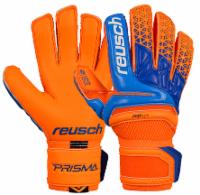
Glove Primer
Share
#askEV

So, I had finished working with our u12 GKs last week and one of the parents of one of the GKs approached me and asked, "What gloves should my daughter get, EV, and what's important in a glove?" Good question.
In answer to the second part of the question, "what's important in a glove", let's look at it. (In answer to the first part of the question....she should get Reusch, of course!!)
1. The most important aspect of any GK glove is the palm. Modern day GK gloves are usually a full palm of varying foams. These foams range in density from quite dense to very soft. The more dense the foam, the less grip on the ball, BUT the longer the life of the foam. (Remember...GK gloves are a perishable item) Conversely, the softer the foam on the palm, the better the grip on the ball, BUT the shorter the life expectancy of the glove.
2. The fit and cut of the glove. As GKs mature and move to higher level gloves, the cut and fit of the glove is vital. For u12 GKs, not so much, just a plain, traditional, flat cut will do. But as the level of the GK rises, he/she may wish to try a rolled finger cut, a negative cut, a flat cut, an extended cut. These cuts--or constructions of the glove--will determine the fit of the glove. Some GKs will find that they prefer a snug to tight fitting GK glove. Some GKs will develop an affinity for a loose, almost "baggy" fit for a glove. This is all determined by the cut of the glove, and GKs need to try out a number of cuts ad styles to determine what they prefer.
3. The back hand protection. Does the GK like some sort of finger protection, and if so, how extensive. Several glove companies offer finger protection. Our Reusch finger protection is called Ortho-Tec (for our high-end gloves), and Finger Support (for our mid-range and youth level gloves). Both of these technologies protect all of the fingers AND thumb as well as the back of the hand of the GK. Some GKs (mostly older) prefer a traditional backhand, which means no protection at all. By the way, one of the GREAT features of Ortho-Tec is that you can customize the protection that you want by simply opening the backhand and removing some of the spines. Customization as it's finest!
4. Wrist closure. Some gloves offer wrist straps which wrap around the wrist and adds extra support as well as enhancing the fit of the glove. Some gloves offer a wrist bandage (an elasticized wrist "sock") which maximizes the fit as well as support before wrapping the wrist strap to add better support. Again, which wrist strap is preferred is up to the individual GK, and he/she needs to try several different glove styles to determine which they like best.
5. Thumb construction. There are a myriad of different thumb constructions depending on the cut of the glove. Most glove companies now incorporate a wrap-thumb in order to allow the GK to get 'good foam' to the ball in any catching situation. Additionally, most good gloves have a 'thumb crotch' that allows for the palm to stretch in any catch configuration, thereby "saving" the stitching and preserving the longevity of the glove.
As you can see, there are a lot of different things that go into the make-up of a GK glove. The key thing for the GK, is to try several different gloves (similar to try different shoes) to determine what feels the most comfortable on the hand, and allows for optimal catching and GKing.
Good Luck to All!
May the ground beneath your dive be soft. May your goalposts be 3 feet wide. May the opposition hit everything right at you.
All the Best--EV
